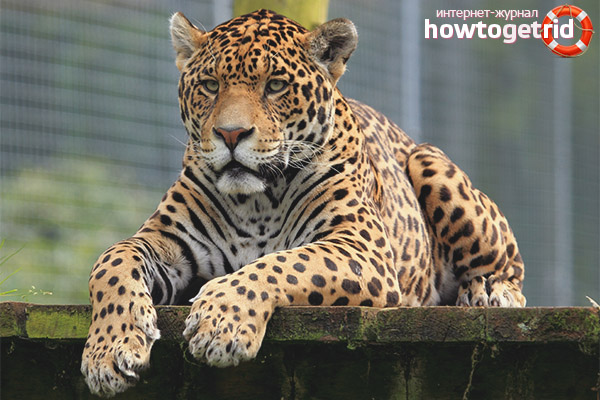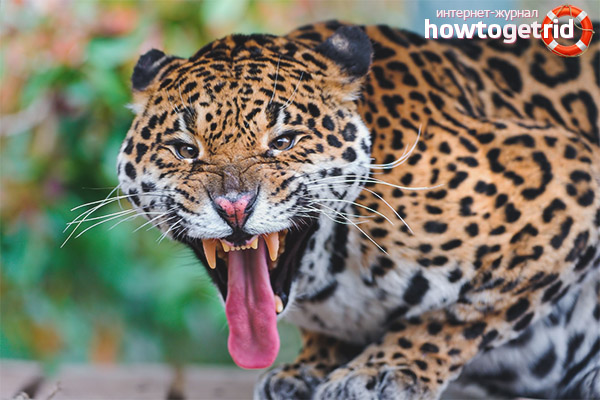The content of the article
Beautiful wild cats have always been the subject of discussion, so they do not require additional advertising. In today's article, we will study the most important characteristics affecting jaguars. They are reckoned among the largest predatory animals, which can differ in bloodthirstiness and agility. A distinctive characteristic of these individuals is the manner in which they obtain their food, but there are other equally important aspects. Let's not get ahead of ourselves, consider everything in order of priority.
Description
- Otherwise, individuals of this family are called panther cats. They are wild, spotty, bulky. This is the most evil predator that can be found in America. Particularly powerful individuals reach about 80 cm along the withers with a graceful trunk length of 1.8 meters. However, jaguars are often not found with such a long body, the average is 1.3 meters.
- The tail portion is shortened (up to 0.5 m.) Or long (up to 0.9 m.). By the mass of the body, wild cats reach 70-135 kg. These animals have pronounced sexual dimorphism. Females are inferior in weight to males, the same applies to overall characteristics. Interestingly, the maximum weight indicator was fixed, which equals 158 kg.
- If a wild mammal lives in an open area, then it will be much larger than its counterparts. If a cat lives in thickets, it loses part of its dimensions. Experts attribute this criterion to the fact that in the open steppe zones there are more cattle, respectively, the diet is better.
- Now we will examine in more detail the exterior of the mammal. With all its appearance, the cat shows strength and grace at the same time. Jaws have a square format, they are strong, with powerful teeth. The head is large compared to the rest of the body. A downed body distinguishes these individuals from leopards. The head is similar to the format of a tiger skull, and the body itself resembles other wild cats. The ears are rounded in format, small.
- The limbs are not as elongated as those of the cat-like representatives. This criterion makes jaguars squat and not so high. Despite their short legs, these individuals run very fast. They masterfully wield their body, driving and killing prey. The coat is short, thickened, soft. By tone, individuals can be reddish, yellowish, sandy. Black spots are scattered on the body.
- The shape of the marks can be completely different, starting with rings, ending with elongated and straight. In the abdominal section, light pigment is observed, as well as on the neck and chest. The internal parts of the limbs are also highlighted. On the legs and head there are black blotches. Yellow marks are observed on the ears.
- These individuals growl strangely, very low, laryngeal. When night falls, they terrify the whole district. Jaguars roar than they look like lions. When wild cats make everyday sounds, they are comparable to a cough or a roar of a saw. When mating, rumbling and purring predominate.
- In genetics, these individuals can be purely black, similar to panthers. But this is extremely rare. Often, babies born with such pigmentation die quickly. However, with proper care, for example, in a zoo or other specialized places, you can get strong and powerful individuals.
Lifestyle
- You should start with the duration of the animals of this breed group. If they are kept in captivity, cats will reach the age of 25. Those individuals that live in the wild, live about 12 years.As you can understand, the life span is so reduced due to the instability of the diet and attacks of opponents. Some cats die from illness.
- These representatives of the family have an inherent feature, manifested in the protection of their territory. Representatives of the male half regularly make rounds to keep everything under control. At least 25 square meters are allocated per animal. km Males need more space than females. They divide the plots according to the format of the triangles. Every three days they change the location in the triangle, wandering from one part of their possessions to another.
- Every 3 months, the animal begins to bypass its lands around the entire perimeter and borders in particular. They do not allow cougars, ocelots and other cats to go beyond the allocated borders. However, if another representative of this species enters the territory, for example, the jaguar can allow it. Mammals prefer to stay awake at dusk. They are selected for hunting before sunrise or after sunset.
- The hunt itself is worthy of discussion. The animal is hiding in the bushes or high vegetation. Can sit in trees, hide near watering places. The attack is carried out from the side or back of the victim when she does not suspect anything. First, the cat clutches its neck, then tries to bite the skull or strangle prey. The rest of the cats do not have the ability to bite the skull.
- When a cat chooses cattle as its food, he immediately tries to heap it on the ground. This will provoke a skull injury, as a result, livestock will be weakened and defeated. Some cats don’t even use their teeth because a broken neck leads to the death of the victim.
- Jaguars do not chase their prey or do it extremely rarely. Victims with excellent hearing can escape as soon as they hear an imminent danger. The cat will not rush after her. The most important feature is that these cats swim beautifully, so they will easily catch up with prey in the aquatic environment.
Habitat
- Jaguars live on the northern border, which stretches from the southwestern states of the United States along the Mexican steppes. The distribution area of animals is really amazing. They settle down to the northern outskirts of Paraguay and Argentina. In addition, the animals in question are often found even in Venezuela.
- It is worth noting that the largest representatives of this species mainly live in Brazil in Mato Grosso. Huge populations of such wild cats are mainly concentrated in the vastness of the Amazon. The considered individuals select habitats based on several criteria.
- In such an area, there must be a body of water nearby. Dense vegetation is an integral part. It is in her that the jaguar disguises itself and hunts. An important fact is that in such open spaces mining should be in sufficient quantities.
- All these resources are most often found in tropical forests with high humidity. Just nature took care of this. It is in this area that reed beds, swamps and river valleys are present. It is almost impossible to meet such felids in arid areas.
- However, in mountainous areas, wild cats are far from outlandish. Even here there are borders. Jaguars do not climb above 2.5 km. above sea level. The rest of the considered individuals are not attracted to mountain forests. Only once noticed an individual that was in Costa Rica at an altitude of about 4 km.
Diet
- Discussed wild cats are real predators that eat only flesh. Such animals prey on different prey. Studies have shown that 85 different species fell into the jaguar's mouth. The presented predators are able to cope with animals without problems, whose body weight can be about 300 kg.
- Wild cats have the greatest weakness precisely for large and fleshy ungulates. Often, jaguars even prey on livestock. In addition, the animals discussed often attack monkeys, porcupines, birds, reptiles, foxes and rodents. When jaguars live near water bodies, they are happy to hunt fish.
- For such wild cats, the tortoise is considered a real delicacy. Such a predator has the power of its jaws to gnaw through a strong shell of an animal. To a special extent, animals love to feast on turtle eggs. They easily find masonry in the sand. However, the cats in question almost never touch carrion.
- It is noteworthy that an animal of noble blood, after catching prey, begins to eat it from its head. Finally, the jaguar leaves a juicy ham. If such a predator managed to fill up a large animal, then the cat will treat it for several days. The jaguar will not leave this place until it satisfies all its needs.
Enemies
- As in most cases, for the most formidable predator, it is the person who poses the greatest danger. The problem is that people constantly exterminate wild cats just for the sake of pleasure and valuable fur.
- In the wild, the jaguar is virtually non-threatening. They have no competitors, and no one hunts animals out of them. Specifically, in their habitat, the individuals in question are located at the top of the food chain.
- An interesting fact is that sometimes jaguars conflict with cougars over the territory. However, the presented animals almost always win. Sometimes the jaguars have serious injuries.
- Predatory cats are so strong and fearless that they often face a dangerous adversary. Jaguars attack caimans, even despite the fact that they are in their native element. As a result, the predator pulls on land monsters, the length of which can reach up to 2 m.
Breeding
- The individuals in question do not adhere to any specific time to begin the mating season. The female often reaches puberty at the age of 3 years. Then she marks the trees with urine, informing the males that she is ready for mating. The female also makes characteristic sounds, the males respond the same.
- Jaguars try to lead a mostly solitary lifestyle. Only for procreation they gather in small groups. Often hunters of such wild cats take advantage of the situation. People learned to lure males with a special sound, imitating a female.
- It is noteworthy that the males do not conduct fights among themselves, the female independently chooses the chosen one and temporarily moves to its territory. After mating, the female is independently engaged in arranging the den and raising young animals. Pregnancy lasts about 3 months. There can be up to 4 kittens in a litter.
Unfortunately, the jaguars are on the verge of extinction and are listed in the Red Book. Currently, hunting for wild cats is prohibited, animals are protected. However, poachers continue to engage in fishing of the considered individuals. Cats are valued for their unique skin.
Video: Jaguar (Panthera onca)













Submit